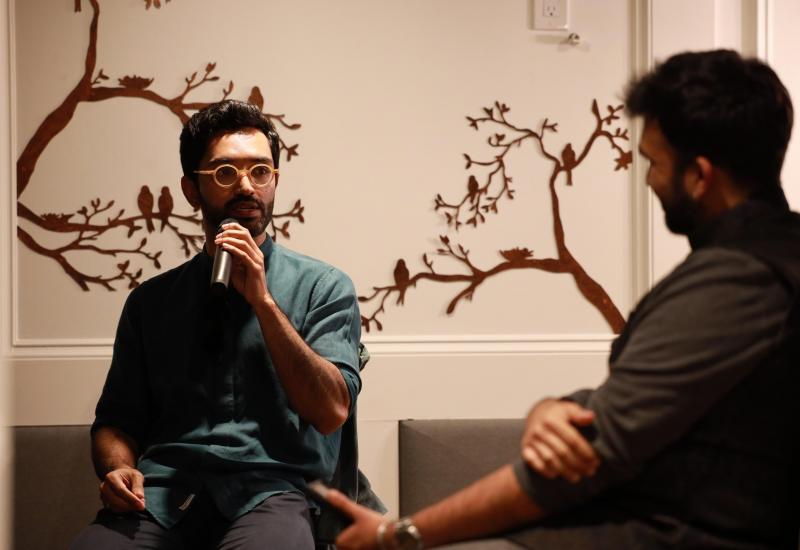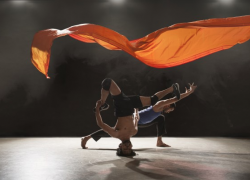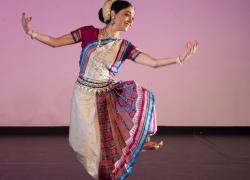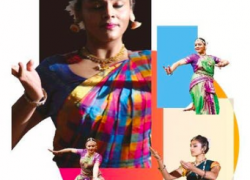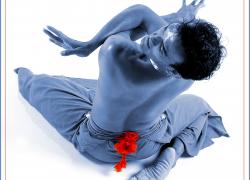He Who Dares…
A profile of Kali Chandrasegaram by Donald Hutera
If words are clues to understanding how a person thinks and functions in the world, there are a few key phrases that pop up in relation to the versatile, London-based dancer and choreographer Kali Chandrasegaram. One comes from his extensive website www.kalidance.net which is subtitled ‘Gateways to differential dance.’ The work documented there certainly gives ample indication of Chandrasegaram’s varied interests as a dance-based artist. Another, more basic notion appears at the end of his emails, which simply reads: ‘May you always be happy.’ Combining the two ideas, the sense is that here is someone who is perhaps happiest when striding into new creative territory.
Now in his late thirties, Chandrasegaram is also a person to whom the various gatekeepers of South Asian dance want to give opportunities. For proof look no further than the ringing endorsement of him as ‘an intriguing, upcoming performer and choreographer of his generation.’ So says Mira Kaushik of Akademi, the organisation through which Chandrasegaram has just completed a two-year stint as one of three recipients of a choreographic development award jointly administered with the Arts Council.
Or consider this praise and encouragement from Piali Ray of Sampad, Birmingham: ‘Kali is more than a dancer – he is a performer who loves to think outside the box and has a creative energy that is gentle but confident. I always believe that to capture the hearts and minds of an audience, an artist has to be a good human being besides having acquired technical expertise. And Kali is that artist.’
Even Shobana Jeyasingh, for whom Chandrasegaram worked a decade ago, retains a strong impression. ‘He had his own highly individual way of moving,’ she recalls. ‘A very perfumed dancer is how I remember him, both literally and figuratively!’
So who is this man about whom others speak in such a vivid, positive manner? Onstage he cuts quite a figure: tall, muscular, imposing but with softer shadings, too. One’s eye is drawn to him, which makes him in particular a magnetic soloist.
Born in Kuala Lumpur, Chandrasegaram began training there in bharata natyam at the ripe old age of 18. It was 1991, and he was realising a dream of which his parents initially disapproved. They had, he says, ‘the orthodox mentality that boys should not be dancers but should instead become a lawyer, doctor or engineer.’ His response to this familial plan? ‘Yeah, right! I guess you can say that after my basic education I became a rebel with a cause and started training at a dance school where my oldest sister went for classes. She also performed in the big theatre productions there, which I secretly desired to be very much a part of for many years.’
Chandrasegaram’s determination still shines through two decades later. ‘I was ready to face my destiny to become an eminent dancer,’ he says, jokingly adding, ‘not quite world-famous since I didn't start at the tender age of five! But nothing was going to stop me. I worked my butt off for seven years, playing the lead in many productions, performing for local television and on international tours. I literally lived my life in that school starting at 6am with yoga classes right up to 9pm or, if there was a performance, 11pm.’
Eventually his family changed their tune and started being supportive of Chandrasegaram’s devotion to dance. Another turning point was being invited to further his dance education in the UK by an uncle and aunt. ‘This was in 1998,’ he explains. ‘After completing my Arangetram (South Asian dance graduation) in Malaysia I did a Higher National Diploma in Performing Arts at University of Hertfordshire, took a year off to work and tour with Shobana’s company and then went back and finished my third year in dance performance at Middlesex University.’
Already grounded in an array of South Asian dance styles, the Western strings Chandrasegaram added to his bow included training in Graham, Cunningham and Humphrey techniques. ‘Learning to free my body from the constraints of South Asian classical dance was a stepping stone in my maturity in terms of thinking about and creating new dance. For me it’s a rollercoaster ride of emotions conveyed through physical intensity.’ The goal, he says, is ‘to assimilate the many different dance vocabularies in my body memory bank to create choreographies which usually don't fit in boxes created by social and cultural norms.’
Professionally he has enjoyed some lucky breaks. ‘I was one of very few South Asian classical and contemporary dancers, choreographers and workshop leaders in the UK to land a regular job as an artist In residence for seven years straight after graduation,’ Chandrasegaram says. This was thanks to Kadam Asian Dance and Music. He tried forming a company ‘and failed miserably. So I decided to be an independent artist who works with others rather than be branded with a company. I have my name, and that's enough.’ Going free-lance, however, has posed challenges. ‘It can be a constant struggle to get work, but it's always good to have good friends and colleagues who trust you.’
Although he can be a flamboyant performer, offstage Chandrasegaram comes across as both innately modest and quietly dedicated. ‘I don't intend to change the world with my art. What I’m interested in is taking traditional forms and breaking the by using individual, personal experiences and belief in one’s self rather than structured, codified formulas. These experiences are presented in a widely accessible, fun, exciting, light- hearted way with references to current social issues. What I want to say [to an audience] is, “Come with me on a journey of self-reflection, contrast, contradiction and exuberance!” It's all about the tease, but with an insight.’
The insights include his own. ‘I’d been happy just being a dancer and a “puppet” choreographer working and re-interpreting ideas from others. Now I’m going through a complete overhaul. ‘ He lays much of the credit for this radical re-invention to the Akademi/Arts Council bursary mentioned earlier. ‘I finally had the chance to give myself time and space to think and work towards developing confidence to go against the grain.’ To Chandrasegaram this means a pursuit of cross-pollinating (‘and poly-amorous!’) acts of creation made with a mix of ‘authenticity and audacity’ that instigates change ‘whilst embracing and then purging ingrained, pre-determined and stereotypical mind-sets until you begin to understand how, in the words of [the genderbending American actor and singer-songwriter] Ru Paul, “The real you is the energy force that created the entire universe!” ‘
Clearly Chandrasegaram combines drive with a fecund imagination. ‘I can't think of choreography without the entire aesthetics of it. Mine usually come as a complete package with the design of sets, costumes and lighting.’ Among his current projects are a solo for odissi/contemporary dancer Katie Ryan that will ‘bring out the Black Swan within her using the sculptures of the Konarak Temple in Orissa as a metaphor, paying importance to the coarse texture of the stones rather than just their beautiful shapes’; a solo for himself that ‘plays on the layering of two different personalities, one a Japanese geisha and the other Rebekah from the Bible (Genesis 24:60), and celebrates the power of women through a male form’; and a piece drawing upon ‘Hindu and Muslim cross-cultural influences in kathak, finding the transition from one to the other using the ideology of the Chaotic Node, a transition state to do with the collapse of the collective lies of a culture.’ It all sounds pretty heady for someone who champions frivolity and proclaims, ‘After all, life should not be taken that seriously.’
As a performer Chandrasegaram has of late been dancing and acting on stilts in an adaptation of The Ramayana for FIPA (Foundation for Indian Performing Arts) that saw him cast as Ravana, ‘a schizophrenic with ten different personalities.’ Elsewhere his experimental side has sought release by collaboratively mixing dance with trapeze, opera, swathes of fabric and site-specific work made in response to architectural space. He’s also continuing to develop JayKali, an androgynous alter ego cum alternative aesthetic that lends a distinctly different cabaret/burlesque flavour to his South Asian dance roots. The precedent is stri-vesham , or cross-dressing as evinced in the classical dance forms of bharata natyam, odissi, kuchipudi and kathakali. For this he was inspired by his training with Hari Krishnan, director of the Canadian company InDance and choreographer of Chandrasegaram’s solo Uma {reviewed in Pulse 111]. ‘I’m just revisiting an age-old tradition and giving it a new light,’ he says. ‘Unfortunately it's a struggle for the South Asian dance community to accept this. It will take time. The bottom line is I love dressing up; since childhood I secretly desired to do it and what better way than the performing arts to express my innermost desires?
‘I’m interested in pursuing very different and varied things,’ Chandrasegaram continues, ‘working across disciplines rather than sticking to one form of dance or creativity. Only when I’m being dictated to by a director does my work have definition…reluctantly!’ Again he repeats, ‘The Asian dance community doesn’t comprehend my work because it’s far from the “safety” zone. I feel like an outcast, but I absolutely believe in what I’m doing. Hopefully one day I’ll be looked at as an artist who dares...a true Daredeva!’








